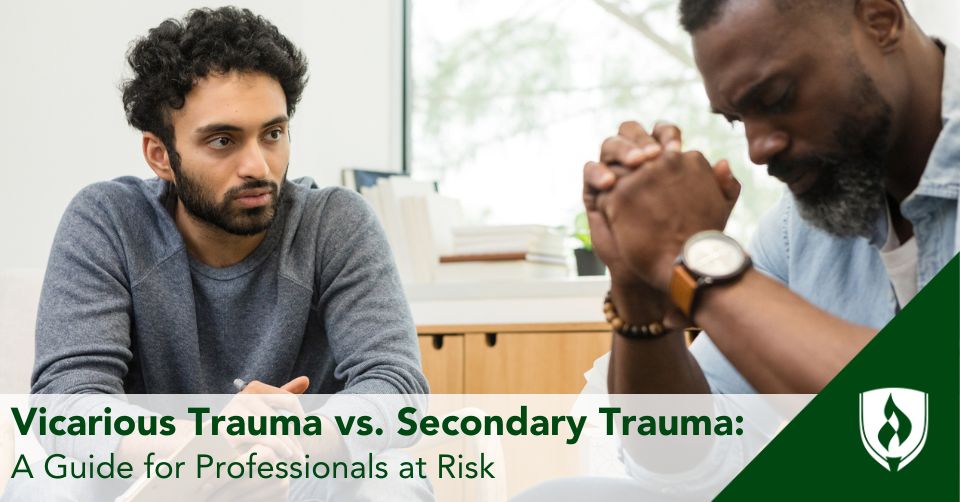Vicarious Trauma vs. Secondary Trauma: A Guide for Professionals at Risk
By Erin Clark Benedict on 03/27/2025

Vicarious trauma. Secondary Trauma. Compassion fatigue. Burnout.
We hear these words often in the helping professions. This is especially true for those of us in mental health or healthcare roles. Working directly in situations involving domestic violence, child abuse, war, or other forms of direct trauma has an impact on the individual.
This can build up to a real problem for empathetic providers, therapists and human services workers trying to support clients and patients through some of their toughest times.
Our clients may be diagnosed with post-traumatic stress disorder (PTSD) or they may not be. But is there a diagnosis or a term for us, the professionals who are impacted by the stories of trauma we hear and witness?
The difference between vicarious trauma vs. secondary trauma
The primary difference between vicarious trauma and secondary trauma is that vicarious trauma occurs after a buildup of repeated, secondary exposure to traumatic stories, and secondary trauma occurs in a moment, in response to one event.
Here's what I mean.
What is vicarious trauma?
Vicarious trauma refers to a change in functioning that is the result of prolonged exposure to traumatic stories and traumatic material. For example, a therapist who works with child victims of sexual abuse could be at risk of vicarious trauma due to the content they hear from a vulnerable population.
Vicarious trauma occurs as a result of constant exposure to trauma. It's indirect, but it’s recurring. We go from session to session, meeting to meeting, hearing story after story of traumatic events that impacted our clients.
Patients and clients overcome fear as they tell their stories. That telling involves someone listening--whether they are an authority who can initiate legal action against a perpetrator or a therapist or someone else who wants to help. If that someone is you, you can develop something called vicarious trauma.
When we help others, a critical part of our job is listening to their stories, feelings, emotions and fear. We hear about the physiological symptoms our clients have, the intrusive thoughts and the difficult or disturbing images or experiences they witnessed. Vicarious trauma is an inundation of suffering and pain that eventually begins to impact our worldview.
We then look for how to resolve each potential crisis, and we are hyper-attuned to finding where trauma exists around us.
Experiencing vicarious trauma brings a shift in thinking that impacts personal relationships and functioning, as we may begin to feel things are out of control. As this shift occurs, vicarious trauma can cause us to pay more attention to trauma than to other things in our lives.
What is secondary trauma?
Secondary traumatic stress is different from vicarious trauma in that it can happen much faster.
Secondary trauma refers to a response that can occur from one incident of trauma.
- A first responder witnessing the scene of a horrific car crash would be at risk of secondary trauma.
- A family member or loved one of someone who experienced a traumatic event is as risk of secondary trauma.
- Health care professionals who witness the grief of parents over the loss of their child are at risk for secondary trauma.
Essentially, secondary trauma focuses on the impact of indirect trauma on the person who is a support or resource.
When a client or loved one experiences a direct trauma, the experience ripples out and impacts others in their lives as well. Individuals who are experiencing secondary traumatic stress often show the same symptoms as individuals who have post-traumatic stress disorder.
Vicarious trauma, secondary trauma and compassion fatigue vs. burnout
Secondary trauma and its symptoms are often labeled "compassion fatigue," a name which reflects the emotional toll empathy can have on mental health professionals as we witness the impact of trauma on our clients.
Offering care, listening ears, support and advocacy for clients who have experienced trauma like child abuse, domestic violence or other traumatic events can build up as professionals do the work they love. As you can imagine, it's very possible for a mental health professional or a caseworker to experience both vicarious trauma and secondary trauma as they do their work.
Often, vicarious trauma, secondary trauma and compassion fatigue all get lumped into the category of burnout. "Burnout" is a term that describes the resulting behavior and impacts of compassion fatigue, secondary trauma or vicarious trauma (or all three) on our work.
A person struggling with burnout may avoid work, miss deadlines, develop strong feelings about their clients, grow more judgmental or show a general lack of effort in their work. This results in dissatisfaction in the job and can lead to professionals leaving the field.
The concept of burnout is known in pop culture, as we hear about the burnout of parents or the burnout of middle managers, etc... But these uses of the term can really minimize the impact of vicarious traumatization found in the helping professions, in which symptoms can escalate to the point where the person meets criteria for PTSD.
Not everyone who experiences burnout is experiencing vicarious trauma. But it's likely that everyone experiencing vicarious trauma is also on the way to burnout.
Coping strategies for vicarious and secondary trauma
Experiencing vicarious trauma and secondary trauma can be common issues in helping professions, but they are not inevitable or unavoidable.
Trauma occurs when our ability to cope is overwhelmed by factors and events happen. Think of it like an immune system fighting off a virus. Our risk increases the more we are exposed.
That said, we know trauma exposure is part of our work. We can take steps to implement coping strategies to minimize the emotional residue other people's trauma brings. When mental health professionals can recognize symptoms of vicarious and secondary trauma that occur internally while working with client's traumatic events, they can mitigate the risk of indirect trauma exposure.
Here are six ways to support yourself against vicarious and secondary trauma.
1. Take the impacts of vicarious and secondary trauma seriously
When you know what to look for, you can catch your symptoms early and take appropriate action. If you know what a fever feels like, you know when you need to stop, rest and take care of yourself. It's the same concept here.
Ask yourself...
- Do you enjoy going to work?
- Do you feel supported in your work?
- Do you feel you make a difference?
- Do you feel your supervisor is supportive?
- Do you feel dread when you get a new client or your client discloses their trauma?
- Do you troubleshoot crisis in any environment?
- Do you worry about physical safety in normal environments?
- Is your outlook on the world positive or negative?
Your answers to those questions can help you decide what to do next.
2. Understand what symptoms of vicarious trauma look like
While different for each person, symptoms of PTSD frequently occur in cases of vicarious or secondary trauma. These can include:
- Intrusive thoughts
- Trouble sleeping
- Hyper-vigilance
Early stages might also include things like missing deadlines, showing up late to work repeatedly and feeling disinterest or even antagonistic toward your work or clients.
3. Seek support
Look for collaborative environments. Mental health professionals who work as a team and feel support from their colleagues and supervisors have fewer symptoms of vicarious trauma when coupled with healthy habits. It may be important to seek support through therapy as well.
A person who fears they are experiencing the symptoms of vicarious trauma or secondary trauma needs support to help manage their symptoms and work.
4. Seek education
When it comes to burnout, many people will ask "are you practicing self-care?" But the real problem is that most professionals don't learn strategies to manage work and life next to crisis, violence, or difficult treatment areas like child abuse or domestic violence.
Education can help here. Learn strategies for coping with trauma. Learn about how trauma works in the brain and body. Learn about how we heal. Courses in human services can be amazing for this.1
A book I recommend is Trauma Stewardship: An Everyday Guide to Caring for Self While Caring for Others.2
5. Know yourself
Know your sources of support, what brings you joy and what feeds you. Know what brings you peace. Genuine and effective self care looks different for every person.
Think about things you can practice that include a combination of mindfulness, physical exercise, healthy eating, rest and social or fun time. It is less important what the activity is and more important that the activity occurs at all.
6. Make a practice of doing things that are good for you
Some ideas:
- Journaling
- Meditation or breath work
- Hobbies like dancing, singing, arts and crafts
- Talking with supportive people
- Eating regular, healthy meals
- Yoga, walking, running, swimming
- Taking vacation
- Setting boundaries about phone calls and work hours
- Good sleep hygiene, getting 7-9 hours of sleep per night
Do you want to help?
Anyone in the helping professions is at risk of developing vicarious trauma due to the nature of our work. But if understanding that doesn't push you away from your desire to help people in some of the worst moments of their lives, working in health care or human services might be perfect for you.
Most of us get into this field because we care. Some of us have our own experiences with trauma and understand how powerful it can be to have someone in your corner. If you want to be that someone, check out Human Services vs. Psychology Degree: Which Path is Right For You? to explore these fields that need people like you.
1Rasmussen University’s Human Services Associate's degree and Human Services Bachelor’s degree programs are not designed to meet, and do not meet the educational requirements for professional licensure as a therapist, counselor, social worker, psychologist, or other similar licensed careers, in any state
2Van Dernoot Lipsky, Laura. Trauma Stewardship: An Everyday Guide to Caring for Self While Caring for Others. The Trauma Stewardship Institute. https://traumastewardship.com/product/trauma-stewardship-everyday-guide-caring-self-caring-others/




